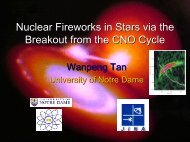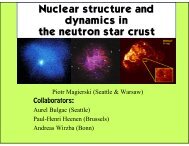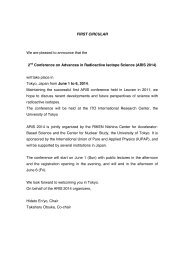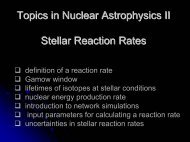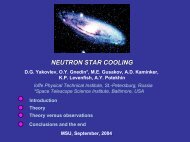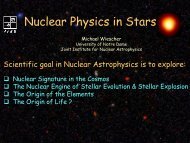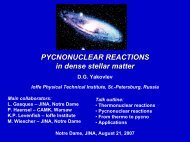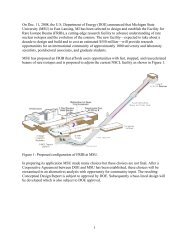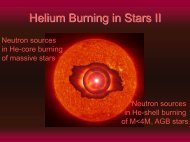OPPORTUNITIES IN NUCLEAR SCIENCE A Long-Range Plan for ...
OPPORTUNITIES IN NUCLEAR SCIENCE A Long-Range Plan for ...
OPPORTUNITIES IN NUCLEAR SCIENCE A Long-Range Plan for ...
Create successful ePaper yourself
Turn your PDF publications into a flip-book with our unique Google optimized e-Paper software.
THE <strong>SCIENCE</strong> • ATOMIC NUCLEI: STRUCTURE AND STABILITY<br />
nuclear properties with increasing excitation energy provides<br />
a fascinating quantum analog to the general problem of transitions<br />
from ordered to chaotic motion. Very neutron-rich<br />
nuclei, far from the common isotopes found in nature, open<br />
the door to investigations of the often-unusual properties of<br />
weakly bound quantum systems. For instance, such nuclei<br />
can include regions characterized by entirely new <strong>for</strong>ms of<br />
low-density, spatially extended, nearly pure neutron matter<br />
akin to that on the surfaces of neutron stars.<br />
Recent advances in understanding the nucleus. Major<br />
conceptual and technical advances have revolutionized the<br />
study of nuclear structure over the past ten years, and<br />
nuclear structure studies have flourished with measurements<br />
and calculations aimed at nuclei both near and far<br />
from the valley of stability. Recent significant advances in<br />
several areas can be briefly summarized:<br />
• Shell structure in exotic nuclei. Investigations of<br />
nuclear shell structure far from stability are fundamental<br />
to our understanding of nuclei and their synthesis<br />
within the cosmos. Recent landmark experiments<br />
include the observation of the doubly-magic unstable<br />
nuclei 48 Ni (Z = 28, N = 20) and 78 Ni (Z = 28, N = 50).<br />
In lighter neutron-rich nuclei, spectroscopic studies<br />
have demonstrated clear evidence <strong>for</strong> a reordering of<br />
nucleonic shells; <strong>for</strong> a weakening of the familiar shell<br />
closures around N = 8, 20, and 28; and <strong>for</strong> the emergence<br />
of a new shell gap at N = 16 in the most neutronrich<br />
nuclei. These studies provide the first indications<br />
that our models of nuclear structure, developed near<br />
beta stability, are not adequate <strong>for</strong> nuclei with large<br />
neutron excesses. In the most proton-rich nuclei,<br />
where, counterintuitively, a strong Coulomb <strong>for</strong>ce<br />
inhibits charged-particle emission, proton decay has<br />
rapidly evolved from an exotic phenomenon to a powerful<br />
spectroscopic tool. First signatures of a new<br />
<strong>for</strong>m of pairing have been seen in nuclei with equal<br />
numbers of protons and neutrons, and a new decay<br />
mode, nonsequential two-proton radioactivity, has<br />
been discovered.<br />
• Collective excitations. We gain insight into the properties<br />
of nuclei by establishing and studying their<br />
basic modes of excitation. Recent advances include<br />
the discovery of the first candidates <strong>for</strong> the new collective<br />
modes of chiral rotation and wobbling motion<br />
in triaxial nuclei. Dynamical symmetries of the<br />
nuclear Hamiltonian have been explored, and the<br />
properties of nuclei with very elongated (superde<strong>for</strong>med)<br />
shapes have been elucidated. In particular,<br />
light superde<strong>for</strong>med nuclei have been discovered.<br />
They provide a unique opportunity to study the<br />
underlying microscopic structure of collective rotations.<br />
Definitive excitation energies and quantum<br />
numbers have been determined <strong>for</strong> the first time in<br />
the key superde<strong>for</strong>med nuclei 152 Dy and 194 Hg.<br />
• Synthesis, structure, and chemistry of the heaviest<br />
elements. The discovery and investigation of the<br />
heaviest nuclei test our understanding of which combinations<br />
of neutrons and protons can give rise to<br />
long-lived superheavy nuclei, and extends the periodic<br />
table, fundamental to all of chemistry.<br />
Significant achievements within the last several years<br />
include the synthesis of new superheavy elements;<br />
the first chemical studies of seaborgium (Z = 106),<br />
bohrium (Z = 107), and hassium (Z = 108); and the<br />
first in-beam gamma-ray spectroscopy of the transfermium<br />
nucleus nobelium (Z = 102).<br />
• Nuclear structure theory. Enormous progress has<br />
been made in the microscopic description of nuclei,<br />
including ab initio calculations <strong>for</strong> light nuclei and<br />
advances in the shell model and mean-field theory to<br />
include improved effective interactions and coupling<br />
to the continuum <strong>for</strong> studies of weakly bound systems.<br />
These advances enabled theorists to make<br />
detailed quantitative predictions of structure and<br />
reaction aspects of nuclei.<br />
Looking ahead: A concise roadmap. Current progress in<br />
understanding the properties of nuclei is impressive, and the<br />
field is poised <strong>for</strong> significant breakthroughs over the next<br />
decade. A deeper understanding of the atomic nucleus will be<br />
achieved by ef<strong>for</strong>ts in both nuclear structure theory and<br />
experiment, where each discipline takes its inspiration from<br />
the other. But the impetus in both areas lies increasingly with<br />
studies of nuclei under extreme conditions, especially those<br />
with extreme proton-to-neutron ratios. In the near and intermediate-term<br />
future, complementary studies both near and<br />
far from stability will be pursued at stable-beam accelerators,<br />
such as those at Argonne and Berkeley Lab and at a number<br />
of universities, as well as at existing dedicated exotic-beam<br />
facilities, especially HRIBF at Oak Ridge and the new projectile<br />
fragmentation facility of the NSCL at Michigan State. In<br />
the longer term, the properties of the new and currently inaccessible<br />
rare isotopes that inhabit the very boundaries of the<br />
29



